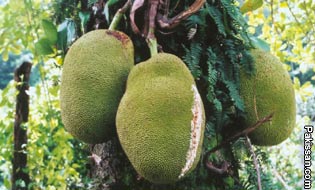|
Plantation of jackfruit in Karachi
By By M. Shafique Ahmed
THE jackfruit (Artocarpus heterophyllus Lamk) popularly
called ‘Kathal’ in Urdu, belongs to the family Moraceae and is indigenous to
China, Malaysia and Sri Lanka. It is cultivated for the edible flesh. When
green, it is a prized vegetable in many Asian and other countries in the West
and is cultivated throughout India, Bangladesh, the East Indies, the
Philippines, Thailand, to a limited extent in Queensland, Mauritius, Kenya and
Uganda.
 It
was planted in Hawaii prior to 1888 and was introduced in the Northern Brazil in
the mid 19th century. Besides Florida, it is cultivated in many other parts of
the US. It
was planted in Hawaii prior to 1888 and was introduced in the Northern Brazil in
the mid 19th century. Besides Florida, it is cultivated in many other parts of
the US.
The jackfruit tree is an astray which is grown in the residential backyards,
parks and fruit orchards in Karachi and its suburbs. It is a sought after dish
in India and Bangladesh for being a cheap option. A jackfruit tree may live for
a hundred years, if looked after well.
Climate and soils: The tree is well adapted to humid tropical to tropical
climates. Frosts and droughts are impediments to growth and fruiting. If roots
touch water, it affects the bearing of fruit and the tree can also die. In the
Himalayan foothills, it can grow at an altitude of 500ft from the sea-level.
Rich, deep soils of medium or open texture with good drainage are considered the
most suitable.
Propagation: Propagation by seed is trying as these are soaked in water for 24
hours to soften the coat for germination. Germination takes 3-8 weeks. Inarching
(approach grafting), vegetative cuttings and the ‘tissue culture’ give good
results.
Fruit bearing: The tree takes long to fruit. Indigenous varieties take 10-14
years to bear fruit, while the improved ones 4-5 years. The tree grows to a
height of some 17 meters and the trunk to 70cm in girth. The leaves are ovate
and the fruit globe or cylindrical covered with spiky growth and is 20-29cm
long, 15-50cm wide, each fruit weighing 4-20kg. A single fruit may contain
100-500 edible seeds and a seed is 2-4cm long, 1-2cm thick and the inner
endosperms become very crispy on roasting or boiling. jackfruit is often called
as the meat of the vegetarians because the flesh of the green fruit is made up
of elongated fibre tissues like meat.
Season: Depending on the local climate the fruit ripens from March-June,
April-September or June-August. The off-season fruiting takes place from
September to December.
Yielding capacity: A tree may yield as many as 150 large fruits annually
attached to the trunk and its lateral branches. While some exotic varieties bear
250 to 500 fruits per year. The fruiting capacity of a tree depends upon the
input supply, weather conditions, and protection from the insect pests and
diseases which are many.
Nutritional value: The pulp constitutes 25-40 per cent of the fruit weight.
Fresh seeds are high in starch but low in calcium and iron but rich in vitamins
B1 and B2.
Uses: The fruit on ripening turns yellow and extremely sweet. It is eaten by the
natives of Malaysia to satisfy their hunger. Tender leaves and seeds are cooked
in India and Pakistan in more than one ways. The canned pulp retains its quality
for several months, while it can be kept for about two years. The seeds are
preserved in oil, syrup and brine.
The rind of the fruit yields a fair jelly with citric acid. Peels yield pectin.
The fruit, rind and the tree leaves are fed to cattle and goats. The white milky
excretion is an important part of birds’ lime and cement that can join the
broken pieces of crockery. The bark of tree is a source of tannin.
Medicinal value: The unripe fruit is astringent in action and on ripening it
becomes somewhat laxative. In China, jackfruit pulp and seeds are considered as
tonic, cool and nutritious. The seed stretch relieves biliousness and the fruit
is aphrodisiacal. The residue of the leaf if mixed with coconut oil heals
ulcers. Mixed with vinegar, the milky juice promotes healing of abscesses, snake
bites and glandular swellings. The wood of the tree is used for shipbuilding,
furniture items, handles of agricultural tools and implements.
Availability: The local production of jackfruit is almost negligible. The tree
is grown out of curiosity in and around Karachi. The fruit is either brought by
the people who visit this part of the country from across the border or from
Bangladesh as a gift. The fruit is also sold in the Empress Market or the new
Subzi Mandi.
It is desirable that when the “tree plantation campaign” is started few saplings
of jackfruit are also planted in public parks and in residential backyards. The
saplings are available at local nurseries.
Courtesy: The Dawn
|
Other Overviews
|
DISCUSS
issue
problems
at
Pakissan Forum
Connect with
the
Pak Agri Community
|
Register
Today at
Pak
APIN
(Pakissan
Agri Experts and Institutes Network)
& become
part of the
Agri
Community
of
Pakistan
|
|
|